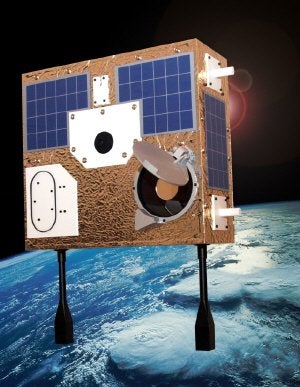We’ve all seen those detective movies where a suspect is under constant surveillance, his every move studied. Using the world’s smallest space telescope, a team of astronomers is conducting a stakeout of a very different pair of suspects ? two active stars that appear to be more youthful and rowdy than our own Sun.
No bigger than an average suitcase, the Canadian Space Agency’s MOST (Microvariability and Oscillations of STars) space telescope has detected a rash of sunspots on a hyperactive “pre-teen” version of the Sun, Kappa 1 Ceti, and a strong pulse in a young adult star called Eta Boötes. Using the world’s most precise light meter aboard the tiny observatory, astronomers are hoping to gain new insight into what our Sun might have been like in its youth.
“All this talk of stellar pulses and hyperactivity must sound like ‘ER meets Star Trek,'” admits MOST mission scientist Jaymie Matthews of the University of British Columbia, who presented the findings last month at the annual meeting of the Canadian Astronomical Society in Winnipeg, Manitoba. “But we really are doing diagnostic checkups of stars at different points in their lives, by placing them under intensive observation for weeks at a time.”
Estimated to be only 800 million years old, Kappa 1 Ceti appears to be covered with sunspots, many larger than those seen on the Sun. MOST has been able to track tiny light differences as these dark blemishes glide across the star’s rotating surface. Rotating once in only nine days, Kappa 1 Ceti also has revealed that its equator is spinning faster than its higher latitudes. This is the first time such detailed observations have been made of a star other than our Sun.
The second star Matthews and his team are looking at is Eta Boötes. They tried a new technique called astroseismology to probe its internal structure. By watching for vibrations on the young Sun-like star’s surface for 28 days straight, MOST was able to accumulate over a quarter million individual pulse measurements. With this new starquake data, researchers hope to shed some light on the actual age and structure of Eta Bo? and begin resolving some of the debate surrounding the Sun’s own adolescence.
MOST carries a small ultra-precision telescope capable of detecting fluctuations in the brightness of stars as small as one ten-thousandth of a percent — ten times better than ever achieved on the ground.
“If all the lights in all the offices of the Empire State Building were on at night,” explains Canadian Space Agency President Marc Garneau, “you could dim the total light by one ten-thousandth of a percent if you pulled down just one window blind by only one centimeter.”
With their newfound results slated for publication in The Astrophysical Journal, the MOST team now plans to use the tiny orbiting telescope to track down other Sun-like stars at various stages in their lives. They hope some of these stars will have planets circling around them. If so, tiny changes in brightness from these star systems could reveal the chemical fingerprints of planetary atmospheres.
“It’s like doing a weather report for a planet outside our solar system,” says Matthews.










